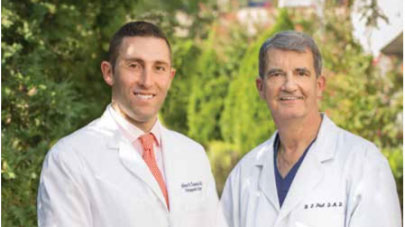Story
At 61, Brian Paul, DMD, was no stranger to neck pain. The periodontist, Navy veteran and self-described “fitness nut” suffered his share of muscle strains, injuries and deteriorating joints over the years, the result of his lifestyle and occupation. But the discomfort was something he could manage.
Until early October 2016, that is.
“All of a sudden, I had a sharp, shooting pain in my neck and shoulders,” Dr. Paul says, adding that many dentists suffer from neck problems. “Within days, it was radiating down into my hand. I couldn’t move my neck; couldn’t sleep. Powerful prescriptions couldn’t touch the pain.”
A trip to his primary care physician and an MRI confirmed what Dr. Paul already suspected: two deteriorating cervical discs, compounded by pinched nerves. Physical therapy, more medications and steroid injections brought temporary relief, but his pain always returned with a vengeance.
“My next stop was surgery,” he says. “But I knew that the standard neck procedure, fusion, could mean the end of my career. I was desperate to find another way.”
New Option, Better Results for Some
In an online search he found Oliver O. Tannous, MD, an orthopaedic spine surgeon at MedStar Orthopaedic Institute at MedStar Washington Hospital Center.
Dr. Tannous—who recently completed advanced fellowship training in state-of-the-art minimally invasive and motion preservation techniques—believed he might be a good candidate for a relatively new procedure, a cervical disc
replacement.
“For the past 50 years or so, anterior cervical discectomy and fusion (ACDF) has been the gold standard for treating disc degeneration,” Dr. Tannous explains. “Yet it’s an imperfect solution. In the process of fusing two discs together, the
spine is forever altered. You end up fixing one problem, but creating another.”
“Now orthopaedic spine surgeons have an option that preserves that motion and function by surgically replicating a healthy disc to replace the damaged one.”
Relief, and a Return to Normalcy
Cervical disc replacement has been in widespread use for only about a decade and was restricted to a single deteriorated disc. Recently, however, the FDA expanded its approval to cover two damaged discs next to each other, clearing the way for the more complex procedure that Dr. Paul underwent.
Cervical disc replacement is an option only for select patients. Those with arthritic neck joints, or joints that have severely lost height over the years from normal wear and tear, for instance, still require fusion. But for those who fit the profile, cervical disc replacement offers real benefits.
“After replacement, the patient typically goes home the next day with a soft collar, or even no collar at all, instead of the rigid neck brace required after fusion,” says Dr. Tannous, who estimates he’s performed about 100 of the complex cervical disc surgeries to date. “Other than avoiding strenuous exercise for six weeks, there are no major restrictions on movement.”
Two weeks after Dr. Paul’s replacement, he was basically painfree and once again working out through yoga, cardio- and strength-training. About six weeks later, his fine motor skills returned, letting Dr. Paul completely resume the career and other activities he loves.
At one point, I thought I’d never be able to work again, but Dr. Tannous returned me to function,” Dr. Paul concludes. “I’m glad I found him. I owe him a lot.”
For an appointment with one of our orthopaedic specialists, call 202-877-6000.














